2022 Puget Sound, WA Coast Chinook, Coho Forecasts Out
Puget Sound and Washington Coast salmon forecasts out this morning show relatively flat expectations for Chinook compared to 2021, but coho are predicted to be up in both regions, especially for rivers draining directly into the Pacific.
The predictions mark the “grand launch” of the annual North of Falcon fishing season-setting process for the region, noted WDFW Director Kelly Susewind in opening comments aired on TVW and broadcast on Zoom.
They follow on the public releases of Columbia River forecasts earlier this year, and the agency’s overall presentation for runs across the state, environmental conditions affecting fish stocks and more are available here.
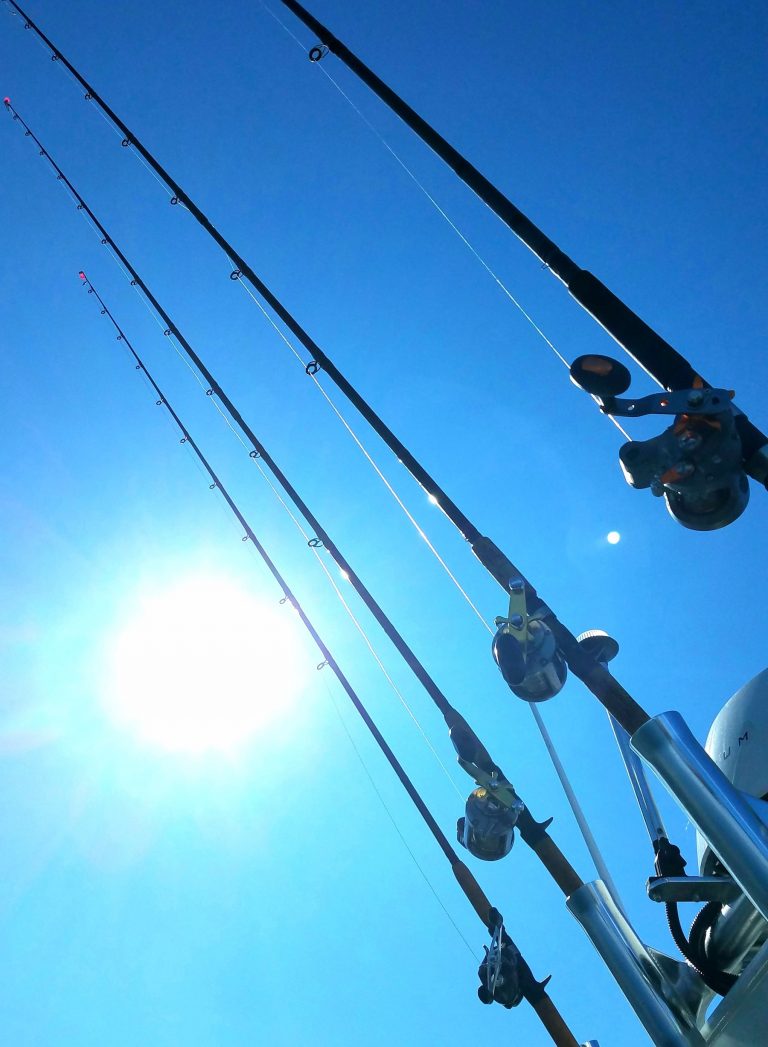
Susewind termed the forecasts “a bit of a mixed bag” – a truism that holds every year – but added the 2022-23 negotiations would also see “big changes” as his agency and tribal comanagers will use their recently agreed-to 10-year management plan for Puget Sound Chinook, which is currently under federal review and otherwise would take effect in 2023.
The 400-page document aims to ensure king fisheries don’t impact recovery and it makes changes to exploitation rates for the Endangered Species Act-listed population. A very welcomed portion also requests the National Marine Fisheries Service reconsider the importance of Mid-Hood Canal Chinook, believed to be stray hatcheries that have failed to colonize several rivers in the fjord but low numbers of which are a perennial fishery constrainer.

Back to the forecasts, for Puget Sound Chinook they call for around 224,000 total kings, a figure which includes roughly 200,000 hatchery fish. As for individual rivers of note, expectations are up for Skagit and North Fork Nooksack springers, and Puyallup, Nisqually, Deschutes and Samish fall kings, but down for Skokomish and Hoodsport falls.
Dr. Kirsten Simonsen, who manages Puget Sound fisheries, drew attention to a “low” forecast for Stillaguamish kings – also a constraining stock – and said the Snohomish’s “low neutral” expectation makes it “another stock we’re going to be keeping our eyes on.”
While the Puget Sound Chinook hatchery forecast represents a 6 percent increase over the 10-year average and 7 percent more than 2021, wild Chinook expectations are 36 below the average over the last decade and well south of averages before the mid-1990s ESA listing.
“We’ll turn fishing around when we turn recovery around,” stated Susewind.
He pointed to long-standing fish productivity issues in the form of straightened and diked rivers and highly altered estuaries, along with headwinds in the form of a growing human population and increasing climate issues including rivers that have become more “flashy” due to flooding that disrupts habitat and redds.
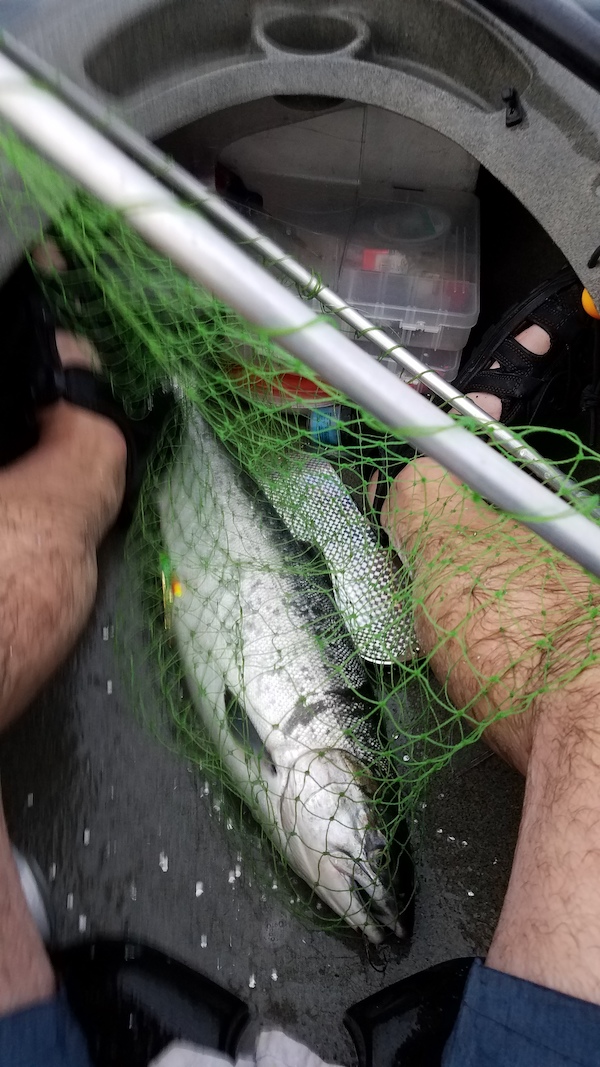
Susewind acknowledged that Governor Inslee’s big policy push to turn the tide on recovery – the riparian-oriented Lorraine Loomis Act – “didn’t fair well” in the legislature (which chronically underfunds salmon restoration and when it does, spreads dollars too thinly) this year after it drew opposition from ag interests who would have been impacted. But he encouraged anglers to put their weight into tweaking the Growth Management Act so it better benefits salmon. A slide late in this morning’s presentation states, “Recovery is not integrated into growth planning.”
Nowhere might be as impacted by a century and a half of development as much as the Stillaguamish Basin and Stillaguamish Tribe Deputy Fisheries Manager Kadi Bizyayeva said her tribe’s two conservation hatcheries were putting out as many Chinook as the facilities and river habitat had capacity for.
Bizyayeva spotlighted the cultural importance of Chinook for her people and acknowledged they were important with sport anglers as well.
“We really do want to see all of us out there harvesting fish,” she said.
The portion of that new proposed state-tribal management plan dealing with increased exploitation rates for Stilly hatchery and natural-origin kings has drawn pushback for not being rationalized well and also for being below federal requirements, as has a “conservation payback” provision to account for one year’s fishery overages in the next year. Earlier this week, WDFW honchos explained the payback would apply to both state and tribal seasons, with the idea being to “make up for … management imprecision.” The agency also said it was “difficult to make an ‘apples to apples’ comparison” between new exploitation rates and standing ones currently used.

On the coast, Chinook expectations are up on the North Coast, down in Willapa Bay, but on the whole hatchery and wild fish forecasts are up 10 and 8 percent over the 10-year average and 3 percent and “neutral” over last year.
On the coho front, the Puget Sound forecast calls for 666,468 silvers (up from 614,948 in 2021). Systems expected to see more fish than last year include the Nooksack (up 11,000), Samish (up 9,000), Skagit (up 21,000), Snohomish (up 4,000), Lake Washington (up 7,000), Green (up 2,000) and the Squaxin Island netpens (up 12,000), but Simonsen noted poor forecasts in the Strait of Juan De Fuca and South Sound.
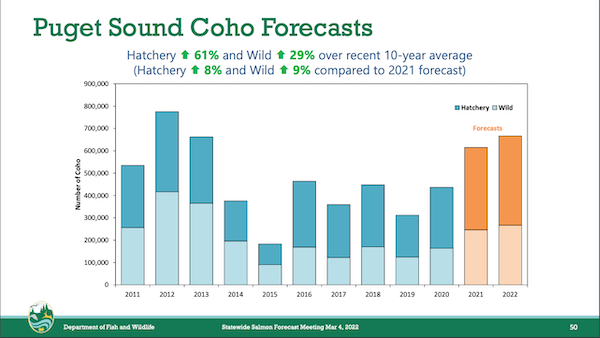
As a whole, hatchery and wild coho forecasts are up 61 and 29 percent over the 10-year average and 8 and 9 percent over last year. That’s good news overall as runs rebuild from 2015’s “coho crash,” though they remain well below high marks seen over four great years in the early 2000s and an outlandish 2 million in 1987.
On the coast, coho runs offered “pretty exciting news,” in Simonsen’s words, with the forecast calling for around 455,000, up significantly from 2021’s preseason guess of 241,000. Expectations are up for Willapa Bay (30,000 more than 2021), Grays Harbor (up 122,000), Quinault (up 22,000), Queets (up 25,000) and for Quillayute summers (up 1,900) and falls (up 10,000).
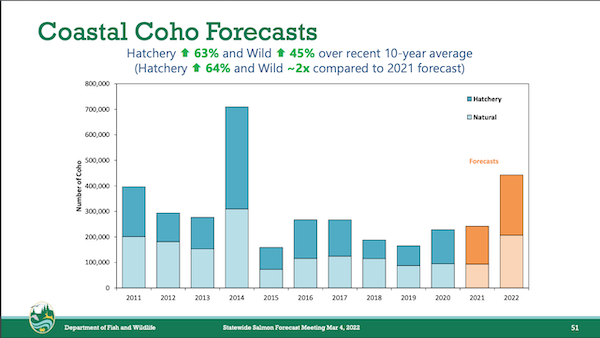
WDFW ocean salmon manager Kyle Van der Graaf said the bump expected on the Queets was “very good to see,” as the stock constrains fisheries on the Pacific.
The hatchery and wild forecasts on the coast are up 63 and 45 percent over the 10-year average.

Chums are slowly rebuilding from low marks in Puget Sound but down sharply on the coast.
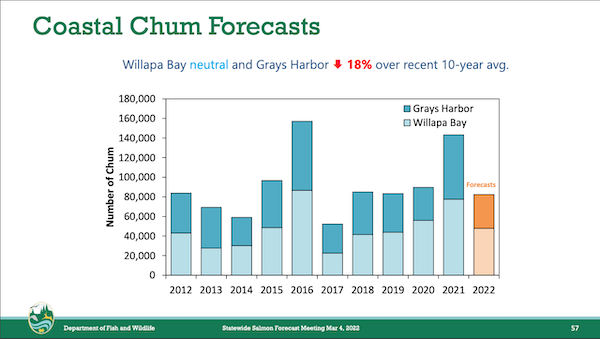
And Mike Smith, don’t even ask me about Lake Washington sockeye: It’s expected to be a cellar dweller 10,165, an “all-time low,” according to WDFW red salmon manager Mickey Agha.
If there’s good news on the sockeye front, it’s that the Baker Lake forecast is 27,081, considered to be “neutral” over the 10-year average, neutral being a designation for runs expected to be from 75 to 125 percent of average.
“Sockeye did better than expected and we hope that trend continues,” said Agha.
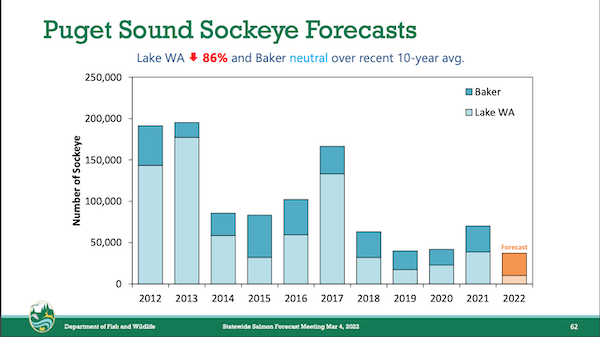
Today’s forecast reveal is part of a month-and-a-half-long process that will wrap up in mid-April with announcement of the 2022-23 salmon seasons. It will include development of fishing proposals for the state’s offshore and onshore waters, as well as rivers and lakes, along with negotiations with tribal comanagers. To learn more about upcoming meetings and participate, go here.
THE FOLLOWING IS A PRESS RELEASE FROM THE WASHINGTON DEPARTMENT OF FISH AND WILDLIFE
Washington fishery managers today unveiled salmon run forecasts for state waters in 2022, with many forecasts looking similar to last year’s predictions, and some slight improvements or declines by area.
Cooperatively developed by the Washington Department of Fish and Wildlife (WDFW) and tribal co-managers, these forecasts mark the launching point for the annual North of Falcon process to develop Washington’s salmon fishing seasons. The forecasts cover expected returns of Chinook, coho, sockeye, and chum salmon in Puget Sound, the Columbia River, and Washington’s coastal areas.
The process includes extensive public meetings and opportunities to provide input through early April as WDFW works with the tribes to develop tentative fishing seasons for the upcoming angling year. North of Falcon is just one part of a larger process that includes the state, tribal governments, federal regulators, other U.S. states, and Canada.
Though forecasts for many areas look similar or somewhat improved from 2021’s forecasts, many returns remain below their historical averages and some fisheries will likely continue to see constraints to ensure conservation goals are met for threatened or endangered salmon populations.
The Department continues to work to preserve and restore habitat, address barriers to fish migration, and manage predation, but responsible fishery management remains a key part of salmon conservation efforts, said WDFW Director Kelly Susewind.
“Fishing is a critical part of Washington’s culture and economy, and we want to make sure people have plenty of opportunity to get out on the water in 2022,” Susewind said. “When we set salmon seasons, we always have to start from a place that ensures this iconic resource will be available for future generations, and that means we sometimes have to make tough decisions in the present.”
The forecasts are based on the latest scientific modeling and a variety of data including environmental indicators such as ocean conditions, numbers of juvenile salmon that migrated to marine waters, and numbers of adult salmon that returned in past years.
The following are summaries of this year’s forecasts, which vary by area:
Columbia River:
About 230,400 “upriver bright” fall Chinook are expected to return to areas of the Columbia River above Bonneville Dam, a slight decrease from the 239,900 that returned in 2021 and well below the 10-year average.
Coho forecasts prior to any river or ocean fisheries occurring, are slightly up from 2021’s return of 829,800 fish, with just under 1 million fish expected to return in 2022, and is more than double than the 10-year average.
“The return of hatchery coho to the Columbia River is expected to be the largest we have seen since 2014, but as always we will have to plan fisheries that meet ESA limits for listed coho, Chinook, sockeye and steelhead,” said Kyle Adicks, WDFW’s intergovernmental salmon manager.
Coho fishing could be impacted if catches of other stocks are higher than anticipated, potentially restricting fishing access in specific areas as happened on a section of the mainstem below Bonneville Dam in 2021.
Sockeye returns to the Columbia are forecast to be up to nearly 200,000, compared to last year’s return of 152,309 fish. However, several stocks are down and are expected to limit lower river fisheries. The endangered Snake River sockeye run is forecasting only 200 fish and Lake Wenatchee sockeye forecast is below the escapement goal.
Washington’s ocean waters:
Coho returns on the Washington coast, meanwhile, are expected to be up significantly over 2021’s forecast. An estimated 454,693 fish are expected to return to coastal areas, up more than 200,000 from last year’s forecast of 241,800 coho. The biggest increases are expected in Grays Harbor and Willapa Bay but returns to many coastal rivers are also expected to improve over 2021.
About 73,000 lower Columbia River “tule” Chinook are expected to return this year, very similar to last year’s forecast. These fish make up a sizeable portion of the recreational ocean fishery. The 2021 return came in slightly above forecast, but still below the 10-year average.
Puget Sound:
Coho returns to Puget Sound and surrounding rivers are forecast to be up overall in 2022 over the previous year, at 666,648 wild and hatchery coho. The forecast called for about 615,000 fish in 2021. Continued low returns to some areas — including the Snohomish River, Hood Canal and the Strait of Juan de Fuca — are expected to impact fisheries in the region. North Sound stocks look slightly more positive, including returns to the Nooksack and Skagit rivers.
Puget Sound Chinook are also expected to be up slightly in 2022, reversing a downward trend from recent years. An estimated 250,440 Chinook are expected to return to the Puget Sound region, about 19,000 more than last year’s prediction. Despite this improvement, Adicks said that low returns of some stocks, like those returning to the Stillaguamish River are likely to constrain fisheries.
WDFW and co-managers recently submitted a 10-year Puget Sound Harvest Management Plan, which, if approved, would provide long-term Endangered Species Act (ESA) coverage for Puget Sound fisheries. While federal regulators consider this plan, WDFW and the tribes expect to use the plan as a framework when developing this year’s salmon seasons in Puget Sound.
Public meetings and feedback opportunities
Information about the salmon season-setting process, including public meeting schedules and materials, are available on WDFW’s website at https://wdfw.wa.gov/fishing/management/north-falcon.
All WDFW public meetings for the North of Falcon process are being conducted virtually in 2022. Members of the public can participate in these meetings by calling in or logging on from a computer or smartphone. There will also be opportunities to submit public comment at these meetings as well as an option for online comments at the North of Falcon webpage.
Upcoming meetings
Ocean fishing seasons: State, tribal, and federal fishery managers will meet with the Pacific Fishery Management Council (PFMC) March 8-14 to develop options for the year’s commercial and recreational ocean Chinook and coho salmon fisheries. The PFMC establishes fishing seasons in ocean waters 3 to 200 miles off the Pacific coast.
Regional fishing seasons: The public is invited to join WDFW at online public meetings throughout March and into April to discuss coastal and regional fishery issues and preferences for Puget Sound and Columbia River. Meetings offer opportunities for public comment, which fisheries managers use to help inform non-tribal fishing seasons.
Final PFMC: The PFMC is expected to adopt final ocean fishing seasons and regional harvest levels for the western seaboard at a meeting spanning April 6-13. State and tribal co-managers will set a tentative 2022 salmon fisheries package for Washington’s inside waters.
